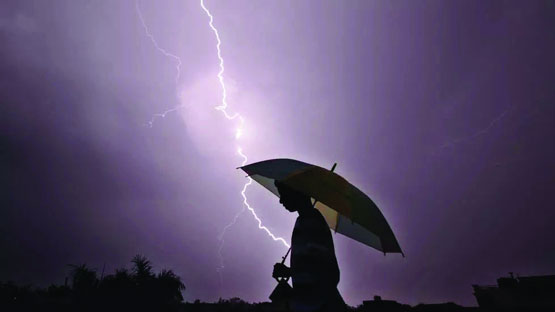How to prevent deaths by lightning strikes?
Staff Correspondent: Lightning strikes claimed the lives of nine people, including five from the same family, at Sirajganj’sUllapara in the first week of September and experts think the loss of lives could have been avoided if there were lightning rods in the area.
MdUjjal Hossain, the UpazilaNirbahi Officer or UNO, said the authorities had placed experimental lightning rods at Upazila’s Udhunia and Bara Pangashi Unions following the incident. The government is focusing on containing the damage caused by lightning strikes in 15 other districts like Sirajganj, which is a hotspot for such incidents. The Ministry of Disaster Management and Relief has funds of Tk 190 million for this in the 2021-22 financial year, according to the Department of Disaster Management.
The project aims to set up 335 lightning rods and lightning insulation machines, known as lightning arresters, in 135 Upazilas across 15 districts.
In 2016, the government declared lightning a disaster taking its frequency in the country and the rate of deaths it causes into account.
Experts said although the months of March, April and May see a higher propensity for lightning strikes, the change of seasons may bring bolts down from the sky from May to September as well.
Lightning rods and other measures can keep everything within 100m of it safe. MdAtiqulHaque, the director general of the Department of Disaster Management, said those placed in different areas for testing are showing good results.
The ministry put Dhaka University’s Department of Meteorology in charge of the feasibility assessment of providing safety to people, animals, infrastructures, electrical establishments and machinery, among other things, from lightning strikes. They delivered a report in March this year.
DISTRICTS PRONE TO LIGHTNING STRIKES
According to the report, Netrokona, Kishoreganj, Jamalpur, Mymensingh, Sunamganj, Habiganj, Rajshahi, Nawabganj, Pabna, Naogaon, Sirajganj, Bogura, Gaibandha, Lalmonirhat, Dinajpur districts are most prone to lightning strikes.
The Department of Disaster Management guided the officials every step of the way in determining the spots to place lightning rods and arresters, setting up IOT facilities, coordinating with the ministry, ensuring central monitoring and going through procurement.
WHY LIGHTNING OCCURS
Meteorologists say thunderstorms occur when cumulonimbus clouds form. With an anvil-shaped top, they are convective clouds or cloud systems that produce lightning, large hail, severe wind gusts, tornadoes, and heavy rainfall. Surface air is warmed by the sun-heated ground surface and rises; if sufficient atmospheric moisture is present, water droplets will condense as the air mass encounters cooler air at higher altitudes. The rapid cooling of the temperature stirs the surrounding air mass and creates thunderclouds.
EFFECTIVENESS TEST
Prof Towhida Rashid, chairman of DU’s meteorology department, said they had been carrying out the feasibility study with assistance from the ministry. They also recommended raising awareness and kickstarting forecasts in the zones prone to lightning strikes.
The lightning rods and arresters, she added, will provide safety for people within 100m diameter of its reach.
The frequency of lightning strikes has increased over the past few years and are expected to rise further in the future, Prof Rashid said. “The climate change-induced events are becoming extreme. Placing more arresters to prevent lightning strikes should be fruitful.”
She stressed the importance of “raising awareness and providing accurate forecasts”.
LIGHTNING RODS: These are made of copper, aluminium and other metals with very low electrical resistance. It allows high voltage electricity to reach the ground safely and smoothly. These 9-12m rods consist of GI pipe and copper wires.
LIGHTNING ARRESTERS: The devices will sit atop the lightning rods. They primarily draw lightning within a particular distance towards the rods and send them down through it. These devices will always remain active and will feature counters to display the number of lightning strikes they encounter.
The Department of Disaster Management chief Atiqul said the work will pay off only when lightning strikes the rods. “We’ve tried to show where to place them. If lightning strikes still cause deaths, it’ll be clear that the work was not effective. If no fatalities happen, we’ll know that it worked.”
“We’re getting reports from the field. We’ll be able to speak about the benefits once we get a full report after setting up the devices is complete in all the places.”
President Joe Biden tests positive for COVID-19 while campaigning in Las Vegas, has ‘mild symptoms’
International Desk: President Joe Biden tested positive for COVID-19 while traveling Wedne…








